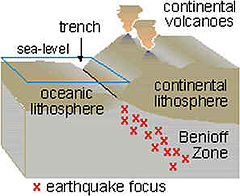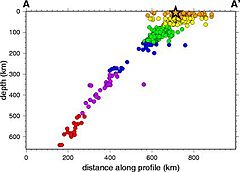42:
31:
144:
introduced a method for determining elastic-rebound strain increments of earthquakes on a particular fault. He determined that the square root of an earthquake's energy is proportional to both the elastic rebound strain increment and the rebound displacement, and developed a way to determine whether
179:
at the interface of the two plates, because the asthenosphere is weak and cannot support the stresses necessary for faulting. In this region, internal deformation of the still-cool down-going slab is the source of the earthquakes. Up to depths of 300 km, dehydration reactions and the formation
209:
portion of the down-going lithosphere, is still debated; the global ubiquity of double
Benioff zones indicates that it must be a process that commonly occurs in subduction zones. Some of the suggested instability mechanisms include dehydration embrittlement caused by the breakdown of antigorite or
200:
In some cases, subduction zones show two parallel surfaces of seismicity separated by tens of kilometres at intermediate depths (50–200 km). A primary example of this is located along Japan's largest island of Honshu, where the Wadati–Benioff zone is characterized by two well-defined lines of
170:
is hotter and more buoyant, resulting in shallow-dipping
Benioff zones, whereas older lithosphere is denser and colder, causing steeper dips. The Benioff zone spans from near-surface to depths of up to 670 km. The upper bound is just beneath the weak sediments in the toe of the wedge of the
210:
chlorite in a hydrated peridotite upper mantle, and un-bending of the slab. Observations from seismic studies indicate that the lithospheric mantle at the intermediate depths where double
Benioff zones occur is dry, which favours the proposed slab-unbending mechanism.
204:
The uppermost seismicity surface is in the crust of the down-going slab and attributed to the dehydration reactions within this oceanic crust resulting in the formation of eclogite. The mechanism behind the lower zone of seismicity, located in the
149:
and the South
American subduction zone, and determined that in both locations, earthquake foci fall along planes dipping ~45° from the trenches. These planes of seismicity were later termed Benioff zones, or Wadati–Benioff zones for
175:, in the interior of the slab that has not yet heated up to match the temperature of the surrounding mantle into which it is being subducted. At depths below the thickness of the lithosphere, earthquakes are no longer generated by
201:
earthquake foci, with a distance between each line of 30–40 kilometers. A study of the global prevalence of double
Benioff zones has found that they are common in subduction zones worldwide.
162:
The angle of dip of the subducting slab, and therefore the
Benioff seismic zone, is dominantly controlled by the negative buoyancy of the slab and forces from the flowing of the
357:
184:
are the main causes of seismicity. Below 300 km, beginning at approximately the 700 °C isotherm, a mineralogical phase change from
171:
subduction zone, and the lower bound is where the brittle-ductile transition occurs. Most earthquakes occur within the 1000 °C
128:
or slip on faults within the downgoing plate, as a result of bending and extension as the plate is pulled into the mantle. The
132:
along the zone allow seismologists to map the three-dimensional surface of a subducting slab of oceanic crust and mantle.
564:
102:
279:
582:
Brudzinski, M.R.; Thurber, C.H.; Hacker, B.R.; Engdahl, E.R. (2007). "Global prevalence of double
Benioff zones".
35:
342:
146:
50:
17:
110:
505:
192:
occurs, and is thought to be the dominant earthquake mechanism of these very deep-seated earthquakes.
93:, the foci of which may be as deep as about 670 km (420 mi). The term was named for the two
556:
380:
604:
654:
145:
a series of earthquakes was generated along a single fault structure. His research focused on the
659:
599:
228:
506:"Earthquakes and plastic deformation of anhydrous slab mantle in double Wadati-Benioff zones"
129:
649:
591:
520:
471:
436:
421:
330:
206:
376:
8:
295:
595:
524:
475:
440:
334:
625:
121:
483:
617:
560:
358:"Kiyoo Wadati and the path to the discovery of the intermediate-deep earthquake zone"
275:
629:
249:
609:
528:
479:
444:
372:
338:
272:
How to Build a
Habitable Planet: The Story of Earth from the Big Bang to Humankind
124:
above active subduction zones. They can be produced by slip along the subduction
577:
575:
321:
Benioff, Hugo (1949). "Seismic evidence for the fault origin of oceanic deeps".
30:
82:
643:
572:
163:
46:
613:
448:
172:
621:
151:
141:
125:
117:
106:
98:
94:
78:
533:
167:
499:
497:
495:
493:
548:
90:
86:
490:
176:
41:
181:
185:
462:
Green, H. W. (1994). "Solving the paradox of deep earthquakes".
27:
Planar zone of seismicity corresponding with the down-going slab
189:
581:
229:"Benioff zone (seismic belt) – Britannica Online Encyclopedia"
398:
553:
Earthquakes: 2006 Centennial Update – The 1906 Big One
89:
zone. Differential motion along the zone produces numerous
343:
10.1130/0016-7606(1949)60[1837:seftfo]2.0.co;2
250:"Developing the theory [This Dynamic Earth, USGS]"
154:, who had made similar observations twenty years earlier.
503:
422:"Rheological controls of Wadati–Benioff zone seismicity"
413:
270:
Langmuir, Charles H.; Broecker, Wally (2012-07-22).
297:Benioff Zone | World of Earth Science Summary
504:Reynard, B.; Nakajima, J.; Kawakatsu, H. (2010).
404:
641:
269:
116:Wadati–Benioff zone earthquakes develop beneath
349:
405:Keary, P.; Klepeis, K.A.; Vines, F.J. (2012).
316:
314:
419:
323:Bulletin of the Geological Society of America
226:
311:
274:. Princeton University Press. p. 298.
113:, who independently discovered the zones.
603:
532:
455:
34:Diagram of Wadati–Benioff zone, from the
263:
40:
29:
320:
195:
14:
642:
355:
461:
547:
409:. Wiley-Blackwell. pp. 225–264.
24:
103:California Institute of Technology
81:corresponding with the down-going
25:
671:
484:10.1038/scientificamerican0994-64
420:Brodholt, J.; Stein, S. (1988).
541:
377:10.18814/epiiugs/2001/v24i2/006
36:United States Geological Survey
288:
242:
220:
147:Kermadec-Tonga subduction zone
13:
1:
559:, pp. 40, 41, 138, 139,
213:
513:Geophysical Research Letters
429:Geophysical Research Letters
157:
135:
7:
111:Japan Meteorological Agency
10:
676:
45:Seismicity cross-section,
557:W. H. Freeman and Company
356:Suzuki, Yasumoto (2001).
614:10.1126/science.1139204
449:10.1029/gl015i010p01081
51:15 November 2006, 8.3 M
130:deep-focus earthquakes
58:
38:
44:
33:
534:10.1029/2010gl045494
196:Double Benioff zones
118:volcanic island arcs
75:Benioff seismic zone
596:2007Sci...316.1472B
590:(5830): 1472–1474.
525:2010GeoRL..3724309R
476:1994SciAm.271c..64G
441:1988GeoRL..15.1081B
335:1949GSAB...60.1837B
122:continental margins
67:Benioff–Wadati zone
63:Wadati–Benioff zone
555:(Fifth ed.),
227:Related Articles.
79:zone of seismicity
59:
39:
435:(10): 1081–1084.
329:(12): 1837–1866.
49:subduction zone,
16:(Redirected from
667:
634:
633:
607:
579:
570:
569:
545:
539:
538:
536:
510:
501:
488:
487:
459:
453:
452:
426:
417:
411:
410:
407:Global Tectonics
402:
396:
395:
393:
391:
386:on 24 March 2012
385:
379:. Archived from
362:
353:
347:
346:
318:
309:
308:
306:
305:
292:
286:
285:
267:
261:
260:
258:
257:
246:
240:
239:
237:
236:
231:. Britannica.com
224:
21:
675:
674:
670:
669:
668:
666:
665:
664:
655:Plate tectonics
640:
639:
638:
637:
605:10.1.1.723.3732
580:
573:
567:
551:(August 2005),
546:
542:
508:
502:
491:
460:
456:
424:
418:
414:
403:
399:
389:
387:
383:
360:
354:
350:
319:
312:
303:
301:
294:
293:
289:
282:
268:
264:
255:
253:
252:. Pubs.usgs.gov
248:
247:
243:
234:
232:
225:
221:
216:
198:
160:
138:
54:
28:
23:
22:
15:
12:
11:
5:
673:
663:
662:
657:
652:
636:
635:
571:
566:978-0716775485
565:
540:
489:
454:
412:
397:
371:(2): 118–123.
348:
310:
300:. Bookrags.com
287:
280:
262:
241:
218:
217:
215:
212:
197:
194:
159:
156:
137:
134:
77:) is a planar
57:marked as star
52:
26:
9:
6:
4:
3:
2:
672:
661:
660:Seismic zones
658:
656:
653:
651:
648:
647:
645:
631:
627:
623:
619:
615:
611:
606:
601:
597:
593:
589:
585:
578:
576:
568:
562:
558:
554:
550:
544:
535:
530:
526:
522:
518:
514:
507:
500:
498:
496:
494:
485:
481:
477:
473:
469:
465:
458:
450:
446:
442:
438:
434:
430:
423:
416:
408:
401:
382:
378:
374:
370:
366:
359:
352:
344:
340:
336:
332:
328:
324:
317:
315:
299:
298:
291:
283:
281:9780691140063
277:
273:
266:
251:
245:
230:
223:
219:
211:
208:
202:
193:
191:
187:
183:
178:
174:
169:
165:
164:asthenosphere
155:
153:
148:
143:
133:
131:
127:
123:
119:
114:
112:
108:
104:
100:
96:
95:seismologists
92:
88:
84:
80:
76:
72:
68:
64:
56:
48:
47:Kuril Islands
43:
37:
32:
19:
587:
583:
552:
543:
516:
512:
470:(3): 64–71.
467:
463:
457:
432:
428:
415:
406:
400:
388:. Retrieved
381:the original
368:
364:
351:
326:
322:
302:. Retrieved
296:
290:
271:
265:
254:. Retrieved
244:
233:. Retrieved
222:
207:upper mantle
203:
199:
161:
152:Kiyoo Wadati
142:Hugo Benioff
139:
126:thrust fault
115:
107:Kiyoo Wadati
99:Hugo Benioff
74:
71:Benioff zone
70:
66:
62:
60:
18:Benioff zone
650:Volcanology
549:Bolt, Bruce
519:(24): n/a.
390:7 September
168:lithosphere
91:earthquakes
644:Categories
304:2010-03-02
256:2010-03-02
235:2010-03-02
214:References
166:. Younger
87:subduction
600:CiteSeerX
177:thrusting
158:Structure
140:In 1949,
136:Discovery
630:15963109
622:17556583
365:Episodes
182:eclogite
173:isotherm
592:Bibcode
584:Science
521:Bibcode
472:Bibcode
464:Sci. Am
437:Bibcode
331:Bibcode
186:olivine
109:of the
101:of the
628:
620:
602:
563:
278:
190:spinel
65:(also
626:S2CID
509:(PDF)
425:(PDF)
384:(PDF)
361:(PDF)
85:in a
55:event
618:PMID
561:ISBN
392:2012
276:ISBN
120:and
105:and
83:slab
610:doi
588:316
529:doi
480:doi
468:271
445:doi
373:doi
339:doi
188:to
180:of
73:or
69:or
646::
624:.
616:.
608:.
598:.
586:.
574:^
527:.
517:37
515:.
511:.
492:^
478:.
466:.
443:.
433:15
431:.
427:.
369:24
367:.
363:.
337:.
327:60
325:.
313:^
97:,
61:A
632:.
612::
594::
537:.
531::
523::
486:.
482::
474::
451:.
447::
439::
394:.
375::
345:.
341::
333::
307:.
284:.
259:.
238:.
53:w
20:)
Text is available under the Creative Commons Attribution-ShareAlike License. Additional terms may apply.

